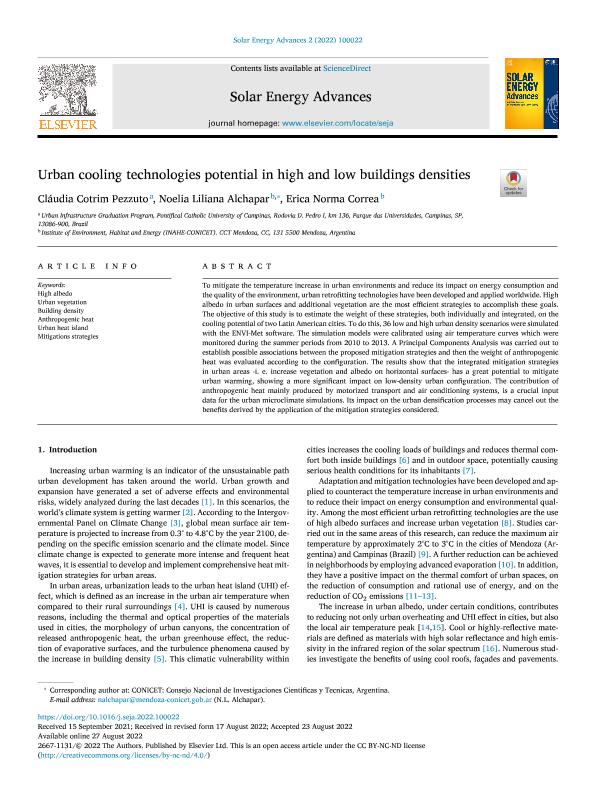Mostrar el registro sencillo del ítem
dc.contributor.author
Cotrim Pezzuto, Claudia

dc.contributor.author
Alchapar, Noelia Liliana

dc.contributor.author
Correa Cantaloube, Erica Norma

dc.date.available
2023-07-28T13:02:11Z
dc.date.issued
2022-08
dc.identifier.citation
Cotrim Pezzuto, Claudia; Alchapar, Noelia Liliana; Correa Cantaloube, Erica Norma; Urban cooling technologies potential in high and low buildengs densities; Elsevier; Solar Energy Advances; 2; 8-2022; 1-13
dc.identifier.uri
http://hdl.handle.net/11336/205926
dc.description.abstract
To mitigate the temperature increase in urban environments and reduce its impact on energy consumption and the quality of the environment, urban retrofitting technologies have been developed and applied worldwide. High albedo in urban surfaces and additional vegetation are the most efficient strategies to accomplish these goals. The objective of this study is to estimate the weight of these strategies, both individually and integrated, on the cooling potential of two Latin American cities. To do this, 36 low and high urban density scenarios were simulated with the ENVI-Met software. The simulation models were calibrated using air temperature curves which were monitored during the summer periods from 2010 to 2013. A Principal Components Analysis was carried out to establish possible associations between the proposed mitigation strategies and then the weight of anthropogenic heat was evaluated according to the configuration. The results show that the integrated mitigation strategies in urban areas -i. e. increase vegetation and albedo on horizontal surfaces- has a great potential to mitigate urban warming, showing a more significant impact on low-density urban configuration. The contribution of anthropogenic heat mainly produced by motorized transport and air conditioning systems, is a crucial input data for the urban microclimate simulations. Its impact on the urban densification processes may cancel out the benefits derived by the application of the mitigation strategies considered.
dc.format
application/pdf
dc.language.iso
eng
dc.publisher
Elsevier

dc.rights
info:eu-repo/semantics/openAccess
dc.rights.uri
https://creativecommons.org/licenses/by-nc-nd/2.5/ar/
dc.subject
HIGH ALBEDO
dc.subject
URBAN VEGETATION
dc.subject
BUILDING DENSITY
dc.subject
ANTHROPOGENIC HEAT
dc.subject.classification
Otras Ingeniería del Medio Ambiente

dc.subject.classification
Ingeniería del Medio Ambiente

dc.subject.classification
INGENIERÍAS Y TECNOLOGÍAS

dc.subject.classification
Ingeniería Arquitectónica

dc.subject.classification
Ingeniería Civil

dc.subject.classification
INGENIERÍAS Y TECNOLOGÍAS

dc.title
Urban cooling technologies potential in high and low buildengs densities
dc.type
info:eu-repo/semantics/article
dc.type
info:ar-repo/semantics/artículo
dc.type
info:eu-repo/semantics/publishedVersion
dc.date.updated
2023-07-04T15:48:43Z
dc.identifier.eissn
2667-1131
dc.journal.volume
2
dc.journal.pagination
1-13
dc.journal.pais
Países Bajos

dc.journal.ciudad
Amsterdam
dc.description.fil
Fil: Cotrim Pezzuto, Claudia. Pontificia Universidad Catolica de Campinas; Brasil
dc.description.fil
Fil: Alchapar, Noelia Liliana. Consejo Nacional de Investigaciones Científicas y Técnicas. Centro Científico Tecnológico Conicet - Mendoza. Instituto de Ambiente, Hábitat y Energía; Argentina
dc.description.fil
Fil: Correa Cantaloube, Erica Norma. Consejo Nacional de Investigaciones Científicas y Técnicas. Centro Científico Tecnológico Conicet - Mendoza. Instituto de Ambiente, Hábitat y Energía; Argentina
dc.journal.title
Solar Energy Advances
dc.relation.alternativeid
info:eu-repo/semantics/altIdentifier/url/https://www.sciencedirect.com/science/article/pii/S2667113122000109
dc.relation.alternativeid
info:eu-repo/semantics/altIdentifier/doi/https://doi.org/10.1016/j.seja.2022.100022
Archivos asociados
